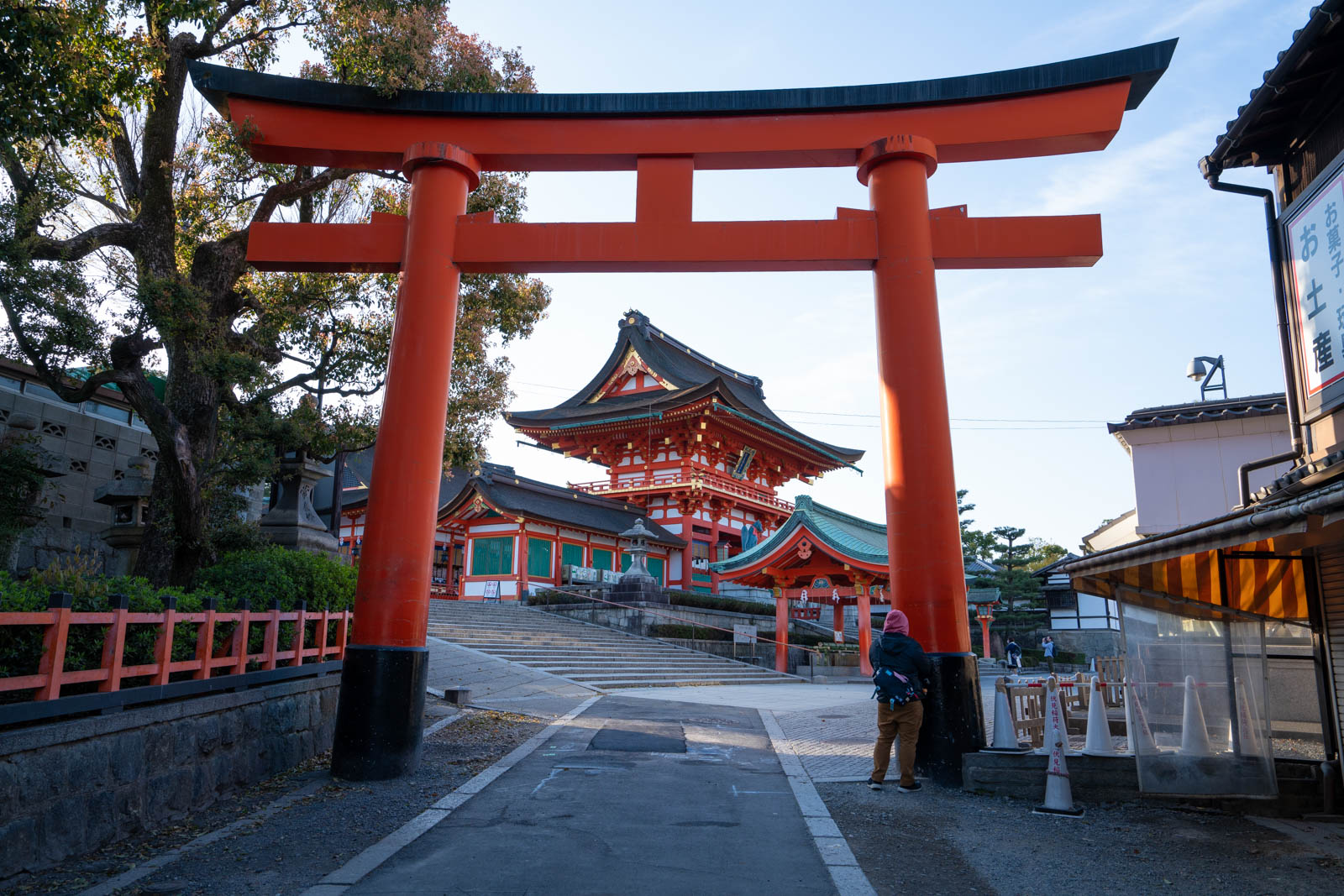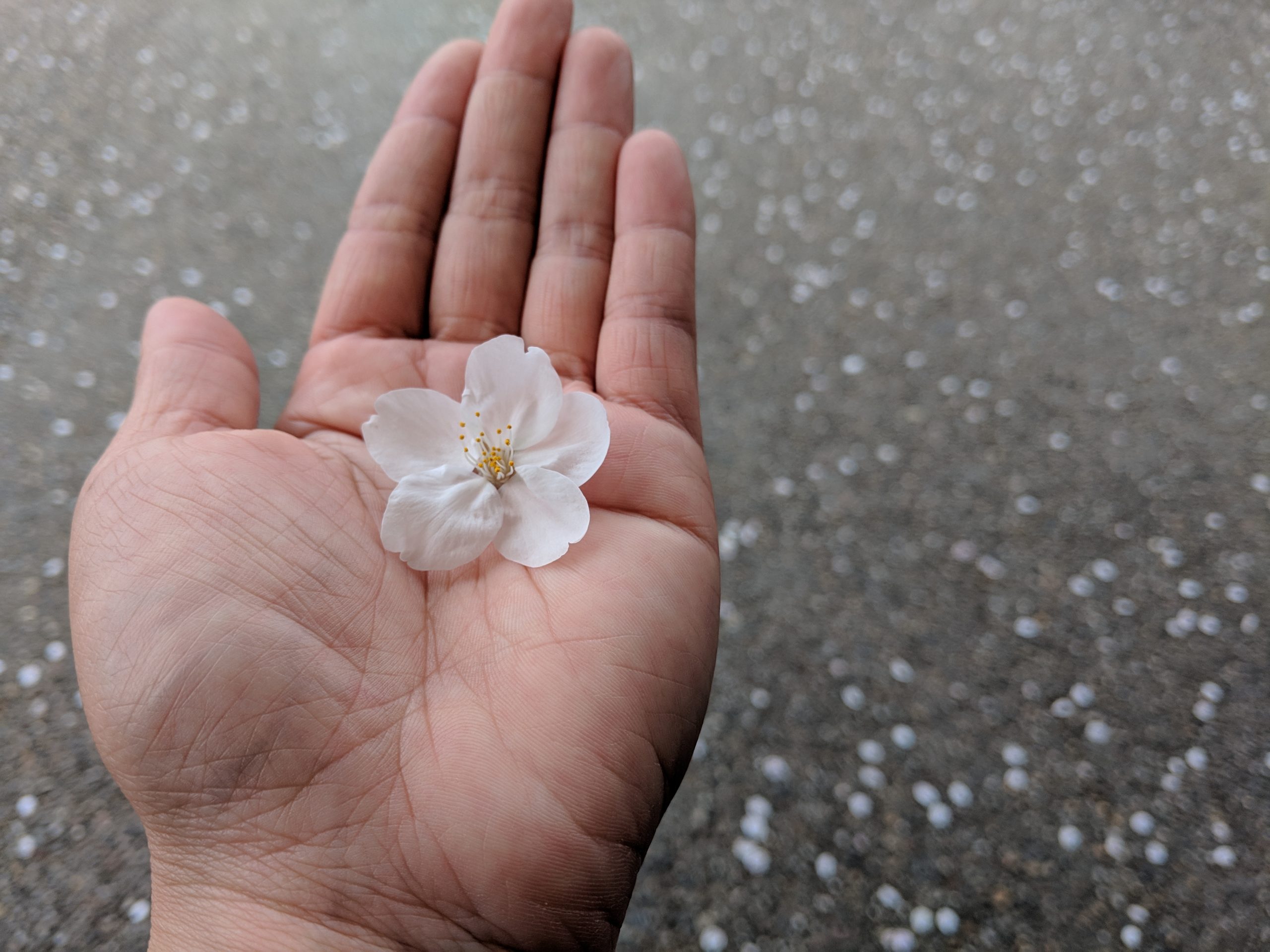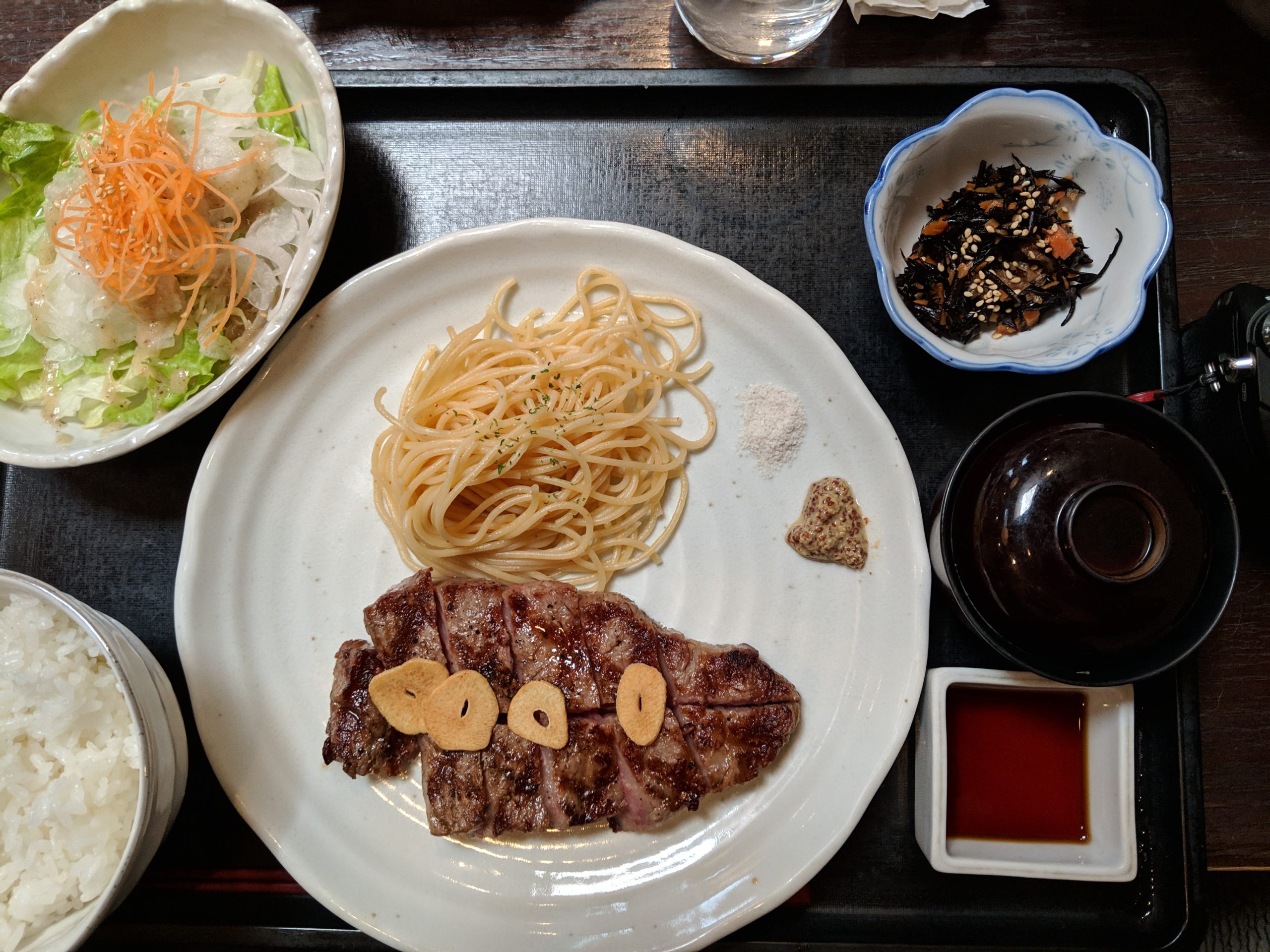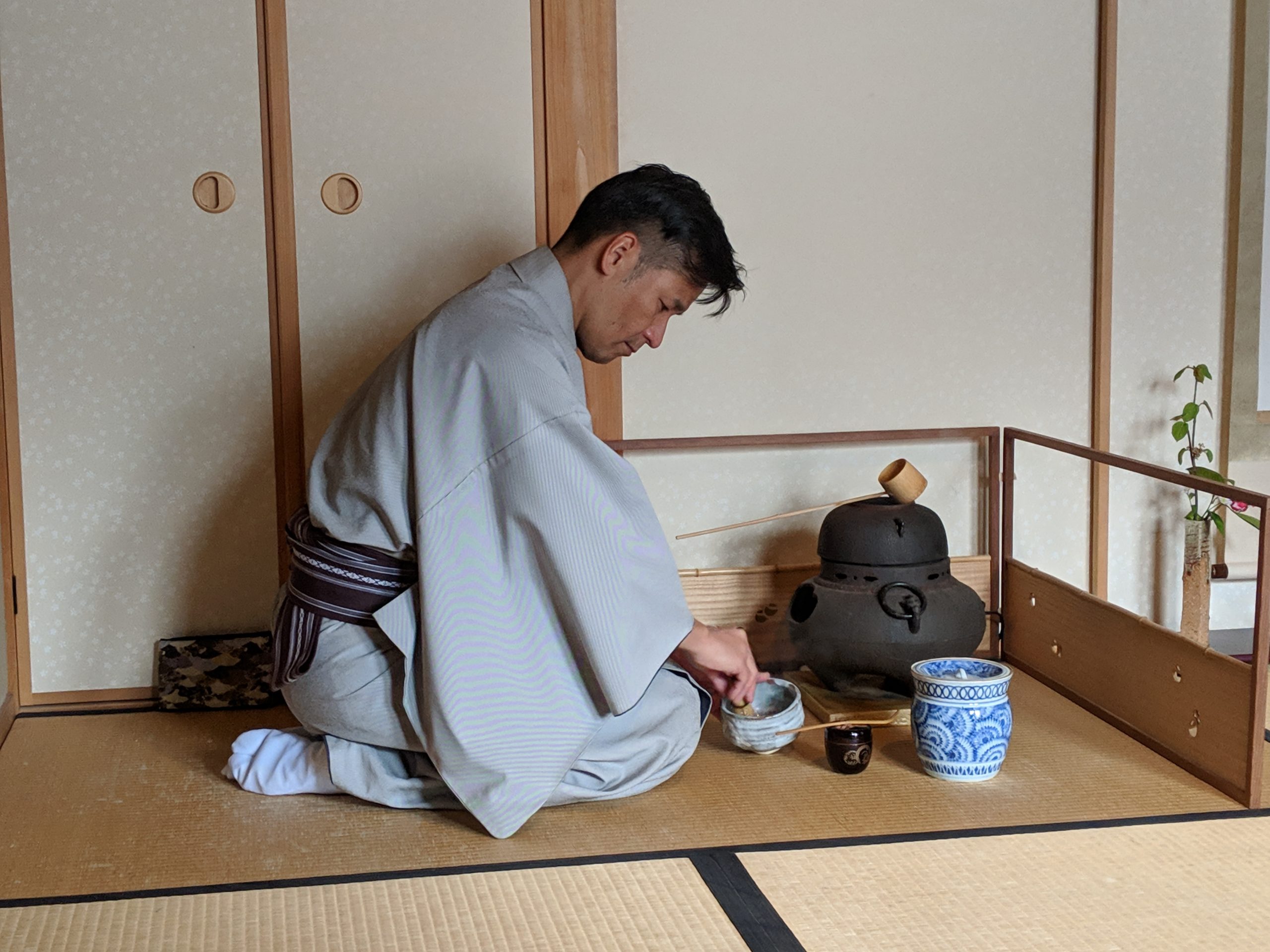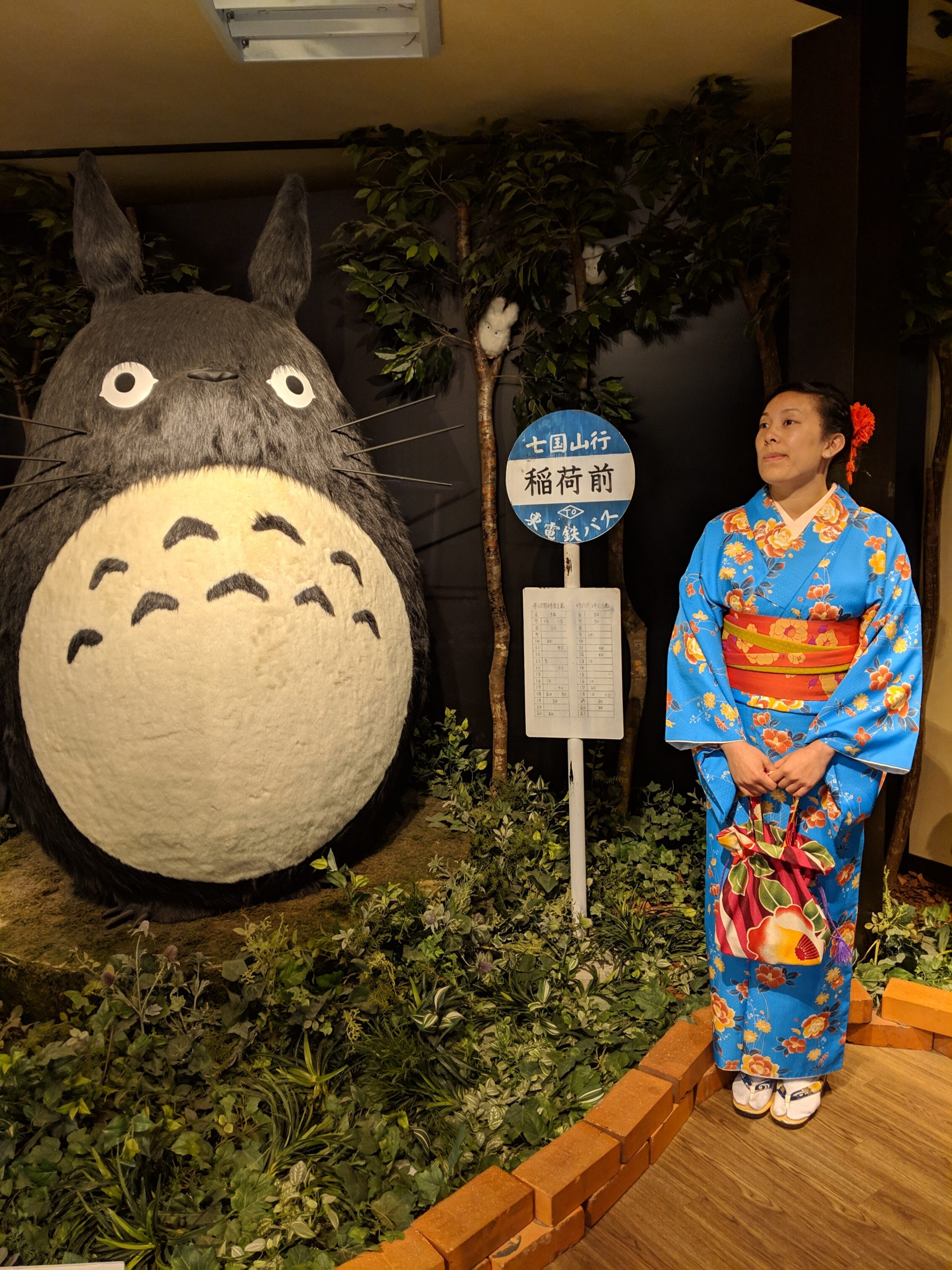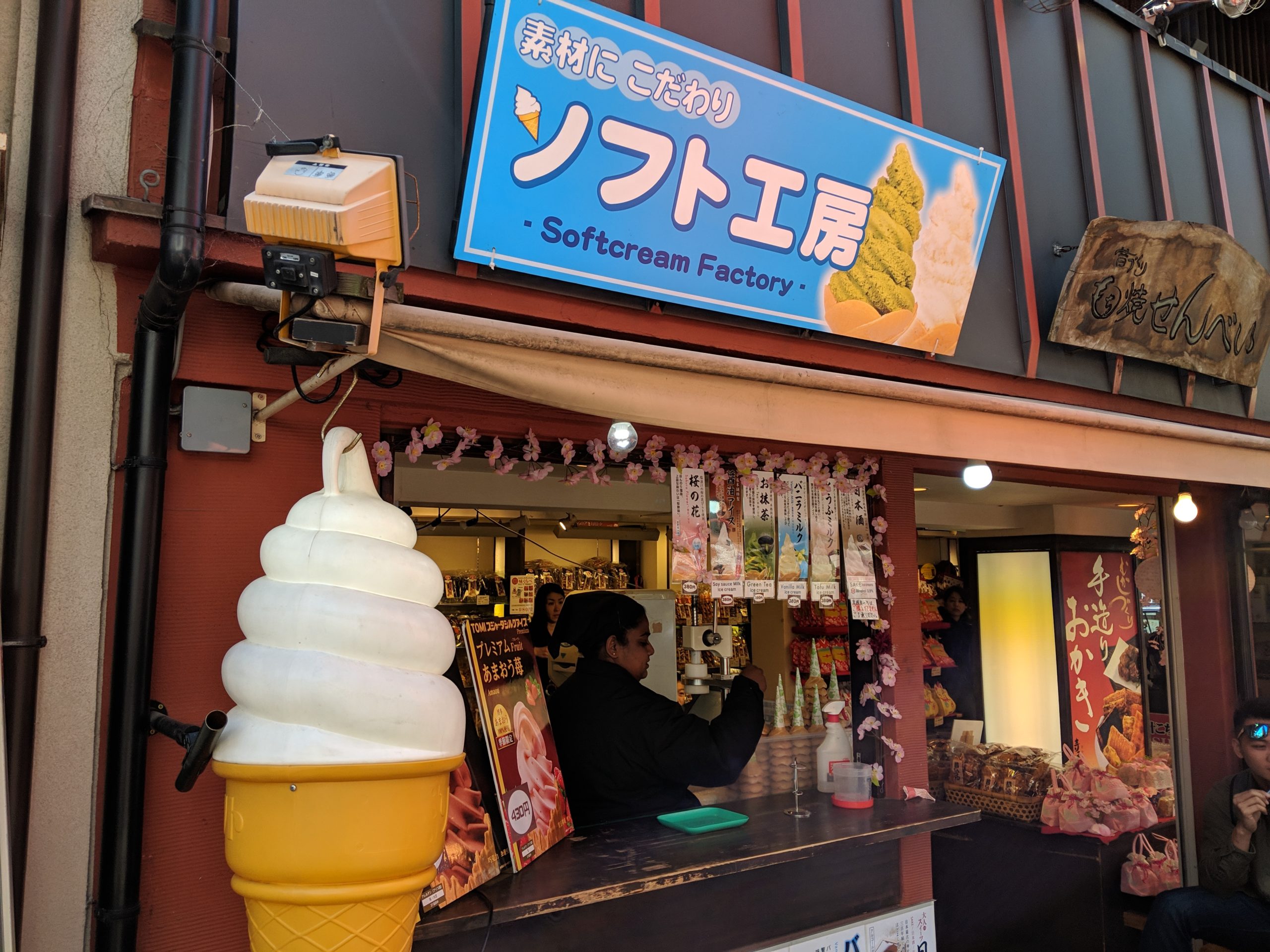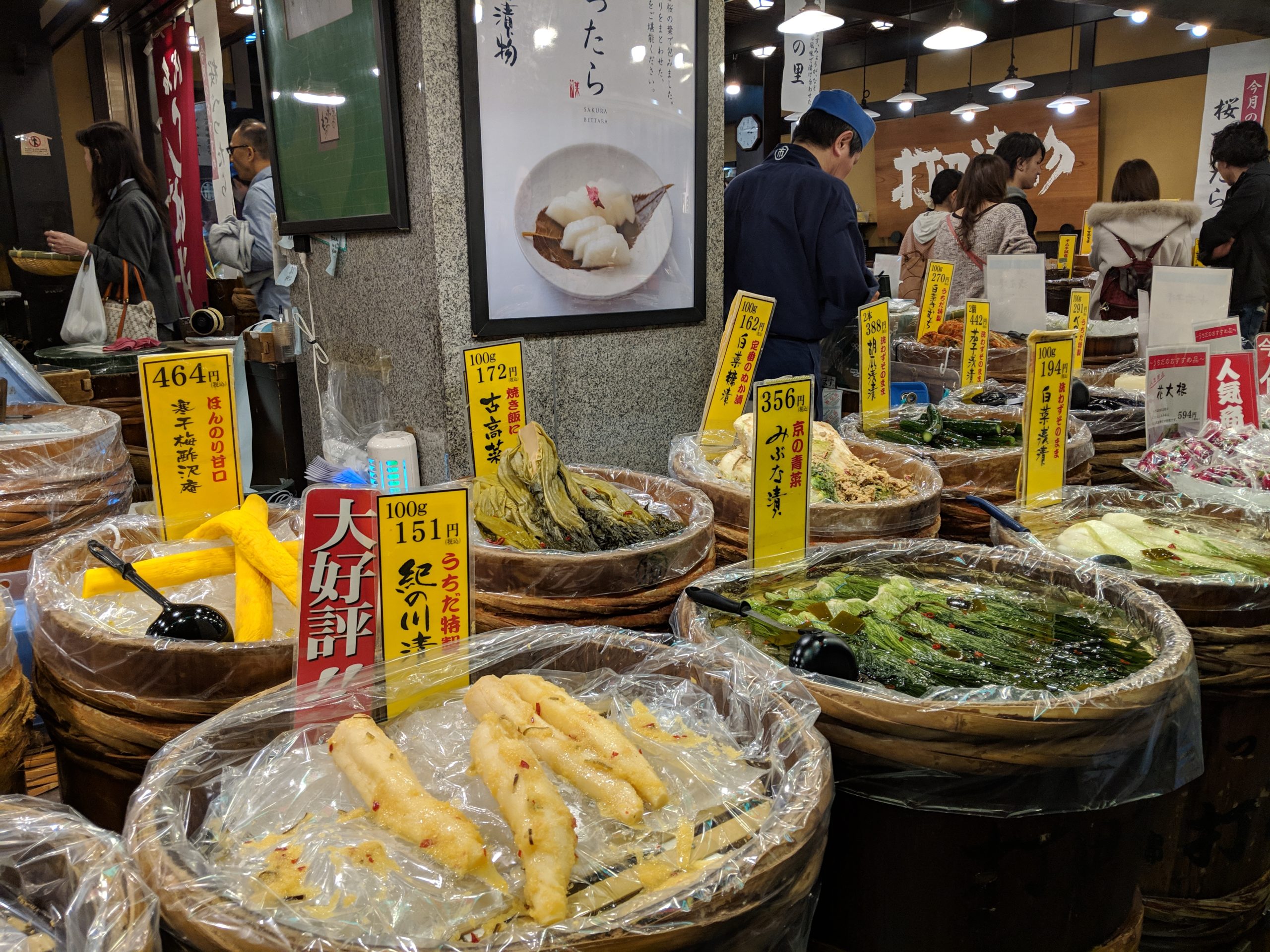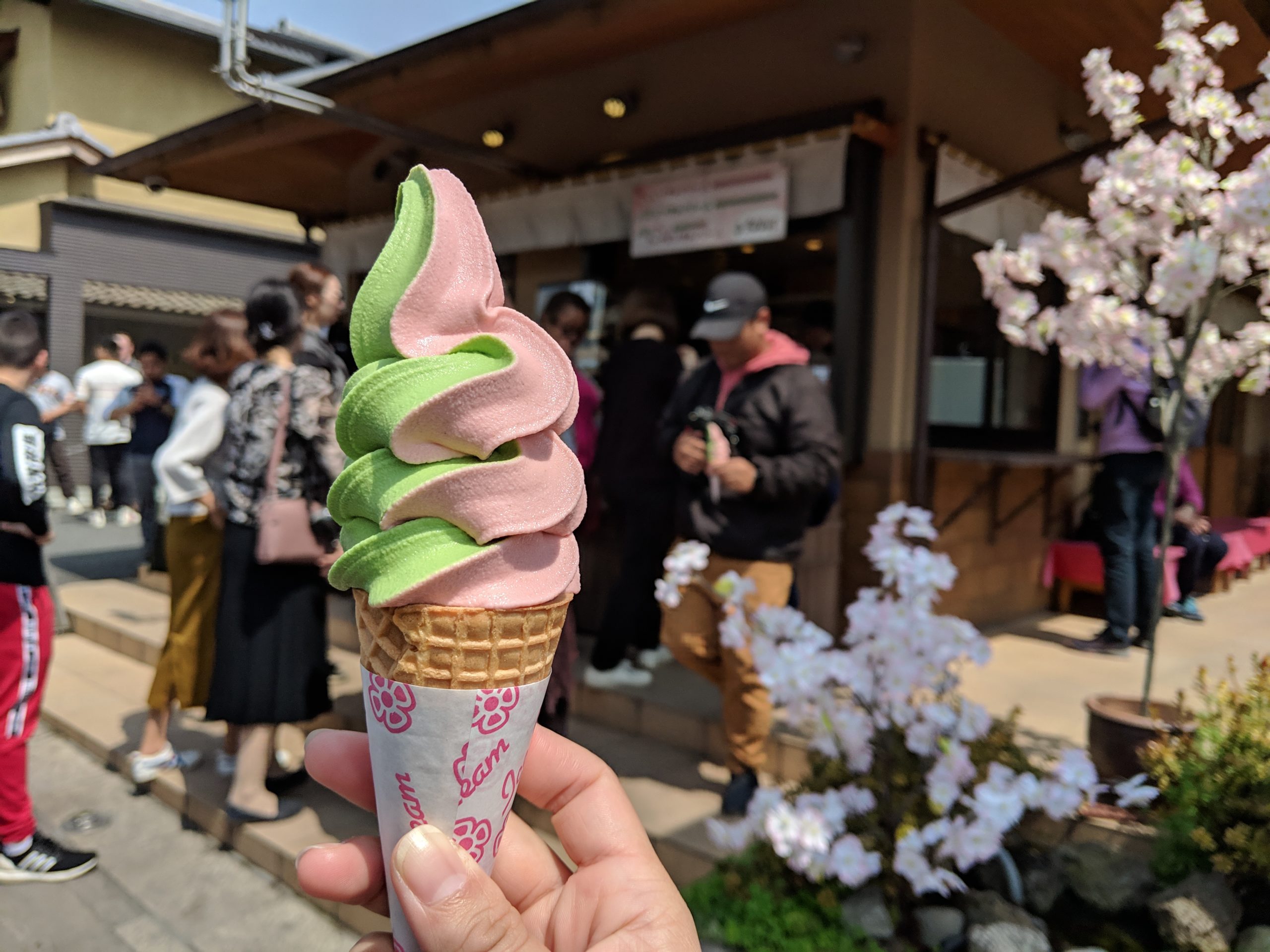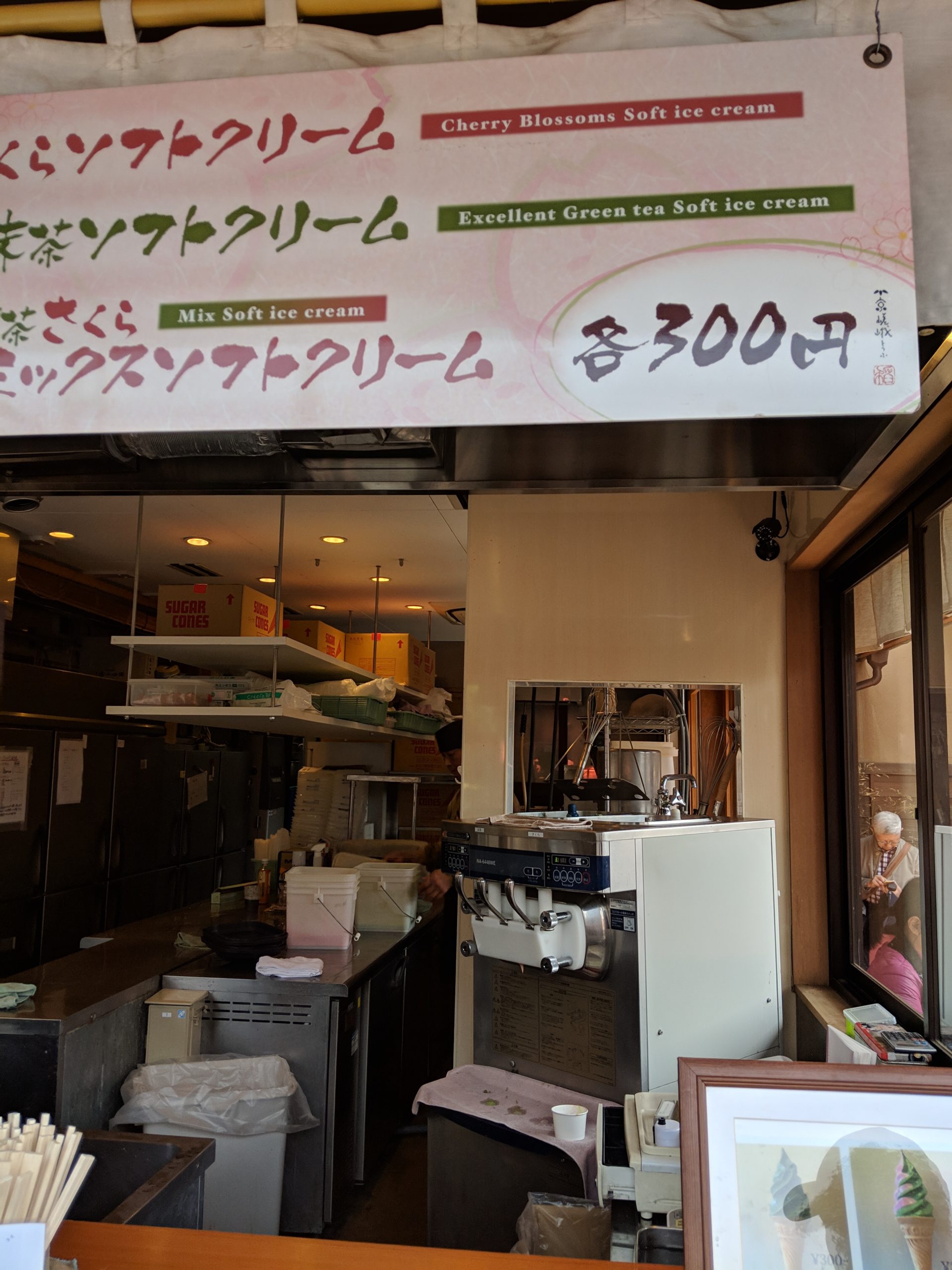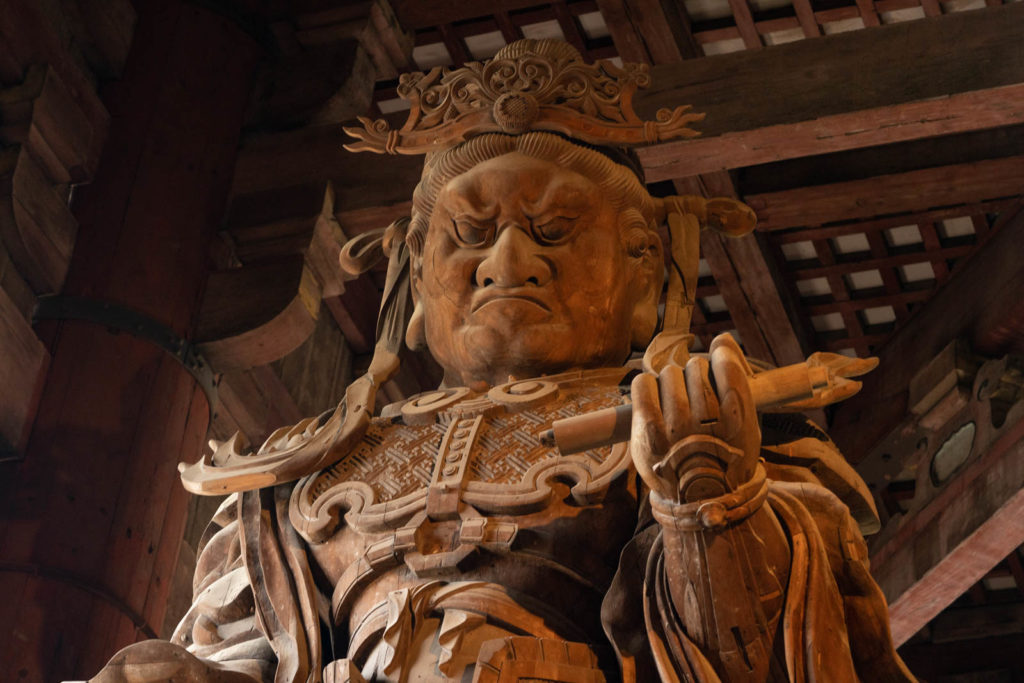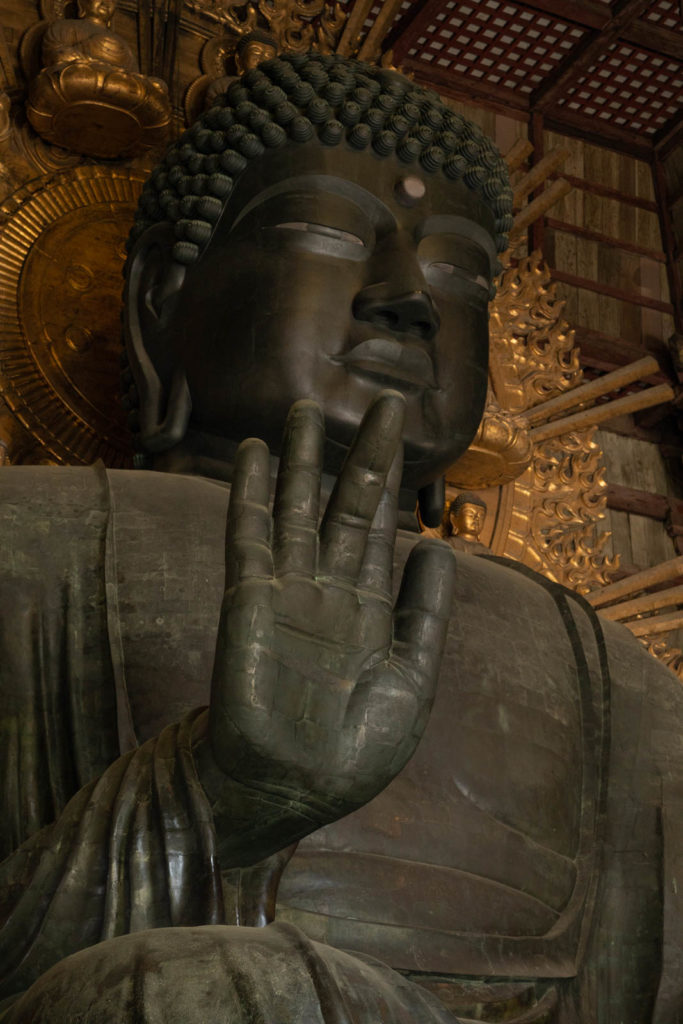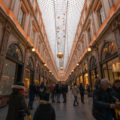overview
Kyoto is one of those beautiful cities were tradition and modernity strike a perfect balance. City center is a packed with Starbucks and Tully’s, but turn the corner and you’ll spot some locals in kimonos crossing the street. We arrived in Kyoto from Yugawara via the shinkasen, which was pleasant enough though with Carl’s parents’ big luggages we had to store them in front of our legs which was a tad uncomfortable (leave the giant luggage at home folks!). The first adjustment we had to make was to stand on the right and pass to the left on escalators – apparently that’s the norm in Kyoto and Osaka but in Tokyo, it was the opposite! Another fun fact is that Kyoto has its own dialect: instead of arigato ありがとう, you say ookini(おおきに). Alternately, a casual thanks between friends is pronounced “ah-zah”, or so we were told at our AirBnB host’s sushi party.

What to do in Kyoto
Visit the Arashiyama Bamboo Grove
One of our favorite places in Kyoto is the Arashiyama Bamboo Grove, where you can walk through the middle of the giant bamboo grove on a gracefully winding path. The experience will vary depending on the seasons; that early April morning the grove was a towering deep emerald that gently shushed in the breeze. The pathway is lined with a fence and brush, which did take a little away from the forest effect I was expecting. Nonetheless, it was still a magical feeling to walk underneath bamboo tall enough to almost close off the sky.

After the forest, wander through the neighborhood back toward the main street of Arashiyama, the quiet residential streets are so beautiful. Stop by Coffee Pado for a coffee break with delightful English tea cups or do a little souvenir shopping across the street, where the sweetest lady sells handmade goods that she and her friend sew – it’s a great spot for hair accessories or things made with kimono silks. After a little browsing, you might finally turn your full attention to the looming temple at the end of the street. The front of the Seiryoji (Sagashakado) Temple stands with a grand wooden gate and glinting metalwork. Beautiful blossom trees framed various buildings and the soft chanting of the monks can be heard despite the crunching gravel paths.
By early afternoon the crowd will swell with tourists dressed in kimono flocking the streets. However, now is also the time all the shops and snacks open and the perfect time to get sakura and matcha ice cream at a little stand just outside of the Saga Tofu Ine Head Store. There’s a Rikku honey shop with delicious honey drinks and also a popular Miffy themed store and bakery.

Visit the Kinkaku-ji (Golden Pavilion)
One of the famous sites of Kyoto is the Kinkaku-ji, or the Golden Pavilion. Because the Pavilion grounds is quite small, it consists mainly of the lake that surrounds the Pavilion and a small pathway around it, you’ll want to visit early or just before closing (the visit doesn’t take too long). We found a long line already started when we arrived just before opening at 9am on a Saturday and it already felt very crowded inside even though it was less than a hundred people. Be sure to go on bright day, as the gold won’t shimmer as spectacularly.

Visit the Nijo Castle
While Nijo castle was not originally on my list, I’m really glad we went. The gardens are lovely during cherry blossom season and the walk through the castle is well organized and offer lots of information via placards. It was one of the few Japanese “tourist attractions” that was well translated for tourists. While most of the murals are reproductions, it’s still stunning to see and learn how they were integral in symbolizing what each room was for or how various elements were influenced by Chinese art. One of the neatest things is the “Nightingale hall”, named such due to the creaking nails and floorboards which makes the craziest squealing sounds, supposedly like nightingales.

Visit the Fushimi Inari Taisha
Arguably the most iconic site in Kyoto, everyone wants their photo of the endless torii (gate) at the Fushimi Inari shrine. As with all places, we recommend going early to avoid the crowds and the heat. To get the full experience, plan on hiking all the way, up and down quite a number of stairs through partial wooded areas. If you make it past the main torii, you’ll find quiet moments among the worn stone shrines stuffed with miniature torii and adorned inari (foxes). Wander among these little nooks for the special details: giant tarnished bells hanging on once colorful cords now fraying and gray. The early morning air is cooler up in the mountains, so take your time and enjoy komorebi, the light filtering through the trees and gates.
After your trek, reward yourself with some creamy tofu or sake flavored soft serve ice cream at the end of the souvenir shop filled street. This is also the part of town to try various inari zushi or sweet tofu-skin pockets filled with rice and sometimes other goodies, thanks to the neighborhood’s namesake. If you’re ready for some lunch, don’t miss out on Kendonya for some of the best handmade udon noodles ever.
Watch the Miyako Odori
One unique experience you’ll get visiting Kyoto in the spring is watching a show performed by the geisha like the Miyako Odori at the beautiful Kyōto Minami-za theater. The show is an elaborate hour with music and dance representing the seasons in vibrant kimonos and subtle movements. Recommended seating is the 1st row of the 2nd floor, so that you’re right at the front, behind the musicians.

Dress up in kimonos
While it can be a slightly controversial affair, we’ve experienced no sort of judgement dressing up in kimonos and that Japanese are genuinely very eager to share their culture. I feel that dressing in a kimono is a great way to understand a bit of Japanese culture, from the subtle details of kimono dress to the fact that you need someone else to help you dress and could not wear a kimono on your own. We rented our kimonos with YumeKyoto, which offers a discount with online booking and were very accommodating when we rescheduled due to rain. They also had a booking deal with the tea ceremony house Camellia Tea Ceremony, which we attended after getting dressed.
The tea ceremony is short but enjoyable and with just enough explanation without too much minutiae for the layperson. Drinking matcha straight is indeed bitter, but is interesting to taste, much like tasting coffees, you get to notice the various notes instead of just sugar or milk. A common phrase you’ll learn during tea ceremony is “osakini” (please excuse me for going before you), which you say to the person that sits after you in rotation. Your tea will also come with a sweet chosen based on the season. In our case it was a “gohaku”, which looked like amber, made of Agar and sugar sweet with a strip of yuzu inside. A helpful lesson during the ceremony was that you whisk the matcha back and forth, not in circles. Note that getting dressed and hair styled took less than an hour and the tea ceremony was about 30 minutes.
The Gion District in general is wonderful to visit. While you won’t likely see real geisha just anytime of day, you will get to see some of the older traditional houses and architecture throughout this district, particularly around Ishibe-koji Alley. Walk through Maruyama Park to enjoy various shrines or just sit under some cherry blossoms. During our visit there was a small festive area with food stalls and outdoor seating in the park, probably due to the cherry blossom season.

Where to see cherry blossoms in Kyoto
Almost anywhere you go in Kyoto you’ll find cherry blossom trees, though the best was probably by along the Kamo river which is lined with trees. Many of the larger temples or their gardens will have a selection of flowering trees, like Nijo Castle. Maruyama Park and Yasaka Shrine will have plenty to see.
What to Eat in Kyoto
Also something to do, or rather eat your way through is Nishiki Market, which is a long street lined with shops, restaurants and food stall. You can find everything from fresh fish and picked vegetables to a cool sticker shop and a tiny patch store that offers the standard Japan flag to family crests patches. Sample some melon pan (soft bread with a crunchy topping, no actual melon flavor) or some traditional sweets like brown sugar mochi or azuki waffles.
Nearby is the international ramen shop Ippuddo, which typically has a long line. We found the ramen tasty but not worth hours long wait, so we opted to visit at the end of the lunch hour, around 2pm for a much more reasonable wait. The miso and the tonkatsu broths were both very rich and flavorful, however the gyoza were unremarkable.

Also in the same area, you can try Nishiki Warai for some okonomiyaki. The restaurant caters well to tourists with a full English menu and booth seating, but note that they allow smoking in the restaurant. We recommend the kyotenyaki seafood as the delux okonomiyaki had too many different sauces on it that overwhelmed the ingredients. Another okonomiyaki spot is Gion Tanto in the Gion district. The restaurant is small but more traditional with tatami mat seating (on the floor) and limited counter space is available for those who prefer not to sit on the floor. Gion Tanto is right at the corner of a little stream and has an open window that offers the view. Try their stewed beef tendon fried udon as well!
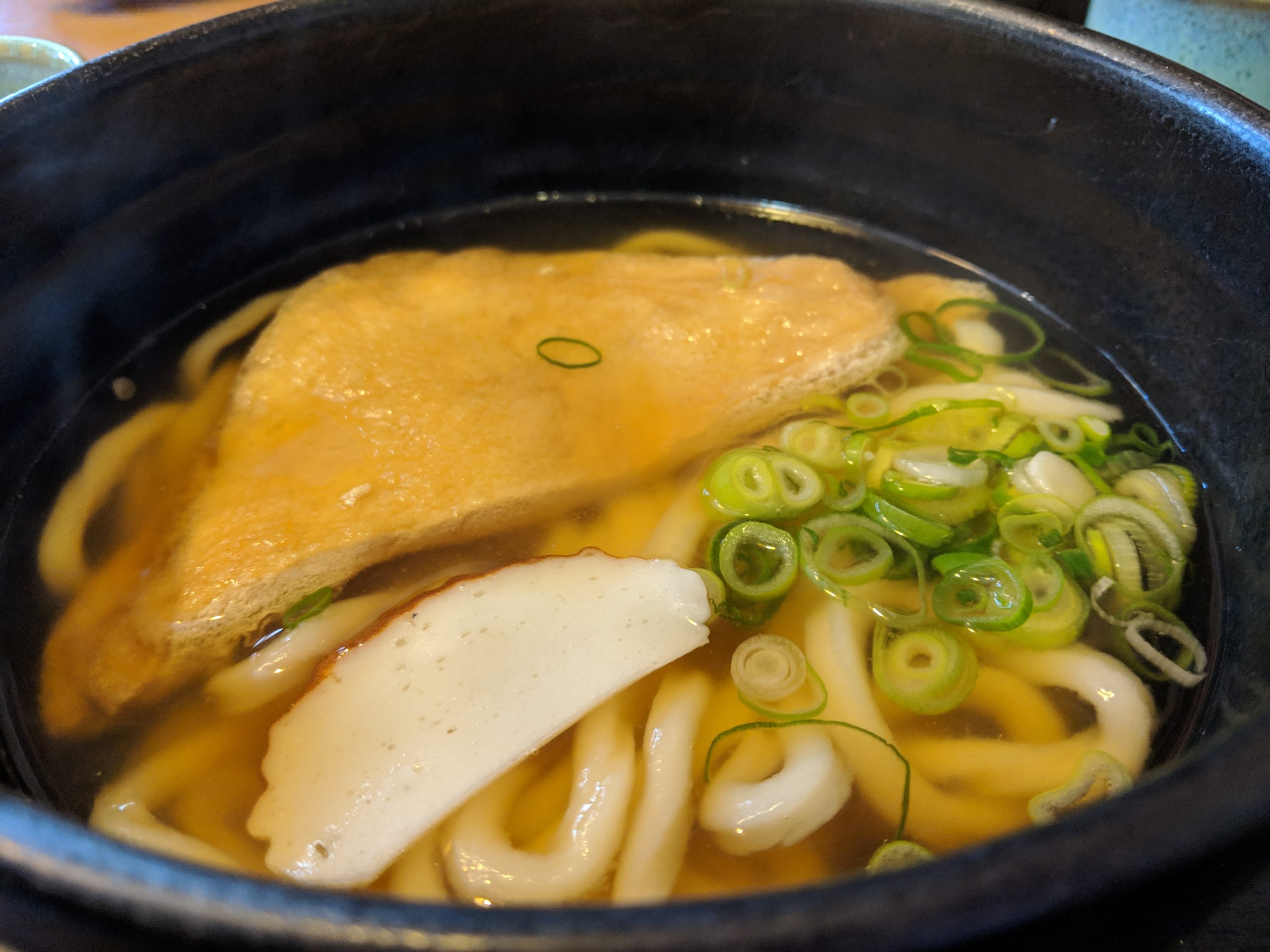
Speaking of udon, we tried the well reviewed Hisago but found the udon was overcooked and too soft. For the best udon in Kyoto, we recommend Kendonya over by Fushimi Inari for chewy handmade noodles. Try their inari udon for a giant sweet tofu and clean broth or if you’re really hungry try their beef curry udon. Service is very friendly, helpful and efficient so we highly recommend this place.

For the ultimate experience of wagyu or Kobe beef, splurge at Hafuu. We came for lunch and I had the sirloin steak medium rare, which was perfect, comes with salt, mustard and sesame seed sauce for dipping but the texture is phenomenal. We’ve tried wagyu beef in other food markets as skewers and such, but because you don’t know what cut of the meat it is, you don’t really know what you’re getting, which can result in a so-so experience of the specialty.
As ice cream lovers, we also recommend indulging in a ice cream parfait in Japan – they do sundaes extravagantly. Try the hojicha or matcha parfait at Maeda Coffee, they had the richest and creamiest matcha without being too sweet. The matcha parfait comes with a scoop of vanilla ice cream, mochi balls, matcha jellies, red beans, matcha cake squares, a chestnut and matcha cookie: all high quality stuff!
If you’re a big tea drinker, don’t miss the Ippoddo store, where you can sample a tea in their tasting room or visit their cafe. Try the bitter and earthy Sencha: hosen or the grassy Gyokoro: Kanro, which is brighter when cold and more mellow when hot. They offer premium and limited edition matcha here and some delicious nutty hojicha which we purchased. We found the service here more friendly and helpful than the other well known tea shop Tsujiri Tea House. Across the street there is a cute bakery called Colombo that offers tiramisu ice cream.
Browse our photos for inspiration or read on for more things to know before going to Kyoto like logistical information or jump down to the details on all the places we recommended.
Photo Gallery
Where we stayed in Kyoto, Japan
$109/night. We stayed at the Traditional Kyoto House 3, which is a small traditional Japanese house hosted by Riko. She also runs a little diner cafe on the property where she occassionally hosts some dinner parties for locals and visitors to meet. The house can run cold and the toilet is in a small outhouse in the courtyard. It may not be the most ideal house for folks who have difficulty with stairs and small inconveniences, but it was definitely a treat for us.
21,565 Y/night for 2 evenings for 2 double rooms at Hotel Mystays. We only happened upon this hotel when we adjusted our plans and had to book another Kyoto stay last minute through HotelTonight (a great resource if you don’t need any flexibility – their communication and customer service is awful). Hotel Mystays is very nice hotel with excellent service and really caters to the foreigners.
Want to give AirBnB a try?
Use our referral link to get $40 in travel credit when you sign up!
Logistics
General
It’s also worth noting that while it’s getting better there’s limited free public wifi around, mainly in the larger shopping arcades. We recommend getting a sim card if you’re one to need internet constantly or if you plan to rely on Google Translate as it doesn’t work offline for Japanese. For fellow digital nomads, keep in mind that working in a coffee shop or cafe is not as widely accepted in Japan. When booking AirBnBs, note if they have Wifi and if it’s a pocket Wifi – convenient but usually minimal data and speeds.
Plenty of really clean public toilets everywhere. Most have TP and soap but not all have paper towels or drying methods. Seems it’s fairly typical for Asians to carry tissue and a small hand towel or handkerchief for this purpose.
In Japan it’s best to travel light as there’s not a lot of room on buses, trains, in accommodations, etc. Many AirBnBs don’t allow luggage storage and coin lockers are expected to be used, which will cost you about 500-700 Yen a locker depending on size.
Vaccinations: Routine Vaccinations
Mosquito problems: None while there
Problems for tattoos: Japan has a history of caution around tattoos as they were a sign of the yakuza, or local gangs. While tourism has created an understanding that foreigners with tattoos are not associated with gangs, those with very large and highly visible tattoos should still be aware that there may be caution or discomfort from the more traditional folk. Many onsens or public baths will also restrict those with tattoos, so ask ahead if you plan to visit one. With my forearm sleeve I did not experience any issues, though April was still a bit brisk and I walked around with a light jacket most of the time.
Traveling as a woman: Standard Precautions
Getting Around in Kyoto, Japan
Kyoto is a large city and it may come as a surprise to visitors that getting around will take more time and money than anticipated. Luckily public transportation is super convenient, though rides will quickly add up. To save on your budget, avoid taxis and walk as much as you can. If you plan to use the trains or buses a lot, we recommend picking up an IC card – either Suica or Pasmo, there’s not a huge difference and both are widely accepted throughout Japan. We grabbed IC pasmo cards and would top up as needed at convenience stores. Metro is fairly straightforward, plenty of signs, does add up. Average trip is at least 130 – 600 yen depending on how many times you transfer and the train you take. The Hyperdia app requires internet and is not the most intuitive, so cross-check with Google. It is easy to screenshot and use to ask station personal they’re willing but plenty do not have good English at all and won’t understand. Some tram or bus trips average around 200 Yen as a flat fee, though if you travel far you’ll definitely pay for the distance.
Be aware that some of the JR lines have cars that require reservations. These cars are intended for those taking the line from city to city. You can prebook those using the smartEx mobile app, purchase tickets at the station or even while on the train (though you can save by booking seats earlier online). If you’re traveling with large luggages you’ll want to book a reserved seat as there will not likely be room in the regular cars. Best to travel very light in Japan, there’s little space for anything.
budgeting
Currency: 1 Yen = 0.0094 USD
For such a technologically advanced country, it may be surprising but cash still remains the preferred exchange. You will need cash in most restaurants and also for public transportation, though ATMs are available via convenience stores or train stations everywhere. Tipping is not an accepted practice in Japan and service people will chase you down to give you back any change you leave. To show your appreciation, simply say thanks!
If you’re planning on shopping, make sure to keep your passport with you. Most major cities offer tax free shopping when you spend more than 5000 Y. There’s a bit of confusion about reporting the tax free documents when you go back home – mostly because everyone experiences different situations. Some people report that they are asked to show their receipts and items, while most are simply told to remove the receipts from their passports themselves. We were not asked to show our items at all.
Daily Budget
$100-120/person: This was for 9 fairly splurging evenings in Kyoto in a traditional house in near the Kamo river. We cooked a couple of meals in but mainly ate out at a variety of budget and fancy restaurants. We walked and used the train system every day. We did a number of activies, like renting kimonos, watching the Miyako Odori show, and a tea ceremony. Accommodations will likely take up most of your budget, though if you can manage with a hostel or capsule hotel you can save yourself a pretty penny. As we were with Carl’s parents, we tried to stay in more roomy and Western style (sized) accommodations and did quite a bit more than usual.
Some typical costs
- 4 Okonomiyaki from Gion Tanto: 5760 Y
- Wagyu lunch for 4 at Hafuu: 18600 Y
- Nijo Castle Admission: 1000 Y pp
- Miyako Odori 4 premium tickets: 22000 Y
- Kimono Rental for 2 at YumeKyoto: 9,720 Y
- Camellia Tea Ceremony for 4: 12000 Y
- AirBnB stay for 4 adults: $109/night
details
Bamboo forest, Higashiyama Ward, Bunkicho, 6, Free – open 5:30a-11:30p. Get there early to get the bamboo lined pathway to yourself. Don’t be surprised if you find all the photographers, especially wedding ones, there at that morning hour.
Fushimi Inari Taisha, inari.jp, 68 Fukakusa Yabunouchicho, Fushimi Ward, Free – Open 24 hours, get there earlier or go in the evening to avoid the crowds and heat! Check out the nearby Kendonya for the best udon.
Nijo Castle, nijo-jocastle.city.kyoto.lg.jp, 541 Nijojocho, Nakagyo Ward, Entry fee – beautiful castle and grounds. The walkthrough of the castle is well organized and placards offer interesting facts throughout the hallways.
Kinkaku-ji, Golden Pavilion, shokoku-ji.jp/kinkakuji, 1 Kinkakujicho, Kita Ward, 9AM–5PM, Entry fee – Famous golden roofed pavilion. The space is really small and it was already crowded right at opening. The website offers a virtual tour and a live feed camera.
Seiryoji (Sagashaka-do) Temple, seiryoji.or.jp, 46 Sagashakadofujinokicho, Ukyo Ward – We did not enter the Buddhist temple but the surrounding garden is quite peaceful.
Miyako Odori, miyako-odori.jp/english, ticket prices vary – one of the four great spring shows in the five geisha districts of Kyōto.
Ippodo Tea, ippodo-tea.co.jp/en/shop/kyoto.html, Teramachi-dori Nijo, Nakagyo-ku, $$ – One of the larger tea shops where you can sample tea and the staff is extremely knowledgeable and helpful.
Ippudo, multilingual.ippudo.com, Shimogyo Ward, Higashishiokojicho, 902, $-$$ – famous ramen restaurant with international locations, we first tried it here in Kyoto. Very good ramen but not worth a long wait, go during off hours to avoid the rush.
Nishiki market, kyoto-nishiki.or.jp, 609番地 Nishidaimonjicho, Nakagyo Ward, opens 9am, no entry fee – Great market place to eat and buy ingredients at. There’s an excellent soy stand, mochi stand, and an interesting shop that sells all kinds of pickled produce.
Seisenkan Nakamura Satonomae supermarket, seisenkan-nakamura.co.jp/shop/satonomae, Sakyo Ward, Tanaka Nokamicho, 18 – Great grocery store where we found some amazingly flavorful tomatos, fresh sashimi grade cuts and other ready made foods.
Apelila, facebook.com/Aperiraapelila, Sakyo Ward, 高野蓼原町36−3 – open 10a-4p. Adorable little bakery.
Hisago, kyotohisago.gorp.jp, 484 Shimokawaracho, Higashiyama Ward, $-$$ – highly rated udon restaurant in the Gion district but we were disappointed in their udon and we prefer Kendonya.
Maeda Coffee, maedacoffee.com/shopinfo/koudaiji, 415-2 Minamimachi, Higashiyama Ward, $-$$ – Gion district location of a cafe chain for excellent matcha and hojicha ice cream parfaits
Teuchi-udon Kendonya, kendonya.com/en, Fushimi Ward, Fukakusa Ichinotsubocho, 41, $-$$ – Opens 11a-6p, Closed Wednesdays. Check their seasonal offerings! super delicious chewy udon noodles. One of our favorite udon spots in Japan so far!
Coffee Pado, 5-6 Sagashakado Monzen Minamichuincho, Ukyo Ward, $ – Cute little coffee shop with dainty Victorian style dishware.
Il ZaccaYa, ilzaccaya.com, 234 Shimohorizumecho, Higashiyama Ward, $$ – Quaint little Italian restaurant but we went for an afternoon coffee.
Hafuu, hafuu.com, Nakagyo Ward, 麩屋町通夷川上る笹屋町471-1, $$$ – Western restaurant that serves wagyu.
Gion Tanto, gion-tanto.com, 372 Kiyomotocho, Higashiyama Ward, $-$$ – okonomiyaki restaurant with tatami seating.
Nishiki Warai, hotpepper.jp/strJ000020265/yoyaku, Nakagyo Ward, Nishiuoyacho, 597, $-$$ – okonomiyaki restaurant with booth seating.
Kimono rental: Yumekyoto, yumekyoto-kimono.com/en/kodaiji, Higashiyama Ward, Masuyacho, 362-5, $$ – We rented kimonos from them twice, great customer service and really accommodating when we got rained out both times and rescheduled our rental appointments. Book online for the best price. Our first rental we did a package with the following tea ceremony shop.
Camellia Tea Ceremony, tea-kyoto.com, 349-12 Masuyacho, Higashiyama Ward, $ – We did combo with tea ceremony package, though it looks like they’ve switched kimono rental companies since our visit.

